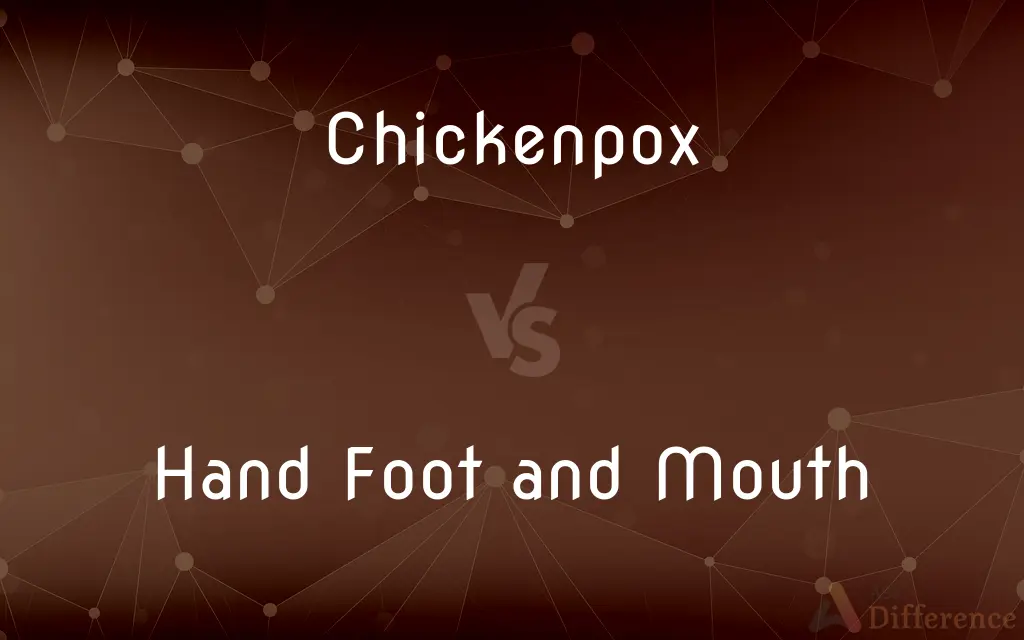Chickenpox vs. Hand Foot and Mouth — What's the Difference?
By Tayyaba Rehman & Urooj Arif — Published on February 1, 2024
Chickenpox is a contagious viral infection causing itchy rashes and blisters, whereas Hand Foot and Mouth Disease (HFMD) affects mainly children with sores and rashes on hands, feet, and mouth.

Difference Between Chickenpox and Hand Foot and Mouth
Table of Contents
ADVERTISEMENT
Key Differences
Chickenpox, caused by the varicella-zoster virus, is known for its itchy, blister-like rash spreading across the body. Hand Foot and Mouth Disease, on the other hand, is characterized by sores in the mouth and a rash on the hands and feet, caused by enteroviruses.
While Chickenpox can affect people of all ages, it is most common in children and once infected, individuals typically gain immunity. HFMD primarily affects children under 5 years of age and immunity to one strain does not protect against others, allowing for possible reinfections.
Chickenpox rashes tend to begin on the face, scalp, or trunk, developing into fluid-filled blisters that eventually scab over. In contrast, HFMD rashes are more localized, appearing on the palms, soles, and sometimes buttocks, with painful mouth ulcers.
Complications from Chickenpox can include bacterial infections of the skin, pneumonia, and encephalitis, making it potentially more severe than HFMD, which usually resolves on its own with mild symptoms, though rare severe complications like viral meningitis can occur.
Vaccination against Chickenpox is widely available and recommended, significantly reducing the incidence and severity of the disease. There is no specific vaccine for HFMD, and prevention largely relies on good hygiene practices to limit the spread of the virus.
ADVERTISEMENT
Comparison Chart
Causative Agent
Varicella-zoster virus
Coxsackievirus A16 and other enteroviruses
Age Group Commonly Affected
Primarily children, but can affect all ages
Mostly children under 5 years
Symptoms
Itchy rash, blisters, fever
Mouth sores, rash on hands and feet, fever
Method of Spread
Airborne respiratory droplets, contact with rash
Close personal contact, respiratory droplets
Complications
Skin infections, pneumonia, encephalitis
Dehydration, rarely viral meningitis
Compare with Definitions
Chickenpox
Chickenpox is a viral infection marked by an itchy, blister-like rash.
After catching chickenpox, Jamie missed a week of school.
Hand Foot and Mouth
Hand Foot and Mouth often spreads in childcare settings.
The outbreak of hand foot and mouth disease closed the local preschool for a week.
Chickenpox
Chickenpox typically confers immunity to those who have had it once.
She never got chickenpox again after her infection in childhood.
Hand Foot and Mouth
Hand Foot and Mouth usually resolves without medication.
They used mouth rinses to ease symptoms of hand foot and mouth disease.
Chickenpox
Chickenpox complications can be severe in adults.
He was hospitalized with complications from chickenpox, which is more severe in adults.
Hand Foot and Mouth
Hand Foot and Mouth can lead to dehydration due to painful mouth sores.
Drinking fluids is crucial for children with hand foot and mouth to prevent dehydration.
Chickenpox
Chickenpox can be prevented through vaccination.
The chickenpox vaccine has made the disease much rarer in recent years.
Hand Foot and Mouth
Hand Foot and Mouth typically affects young children.
Hand foot and mouth is common in toddlers, especially in the summer and fall.
Chickenpox
Chickenpox is highly contagious to those who haven't had the disease or vaccine.
The daycare outbreak reminded parents of the contagiousness of chickenpox.
Hand Foot and Mouth
Hand Foot and Mouth is a viral illness with sores in the mouth and a rash on hands and feet.
Her daughter's hand foot and mouth disease made it difficult for her to eat.
Chickenpox
An acute contagious disease, primarily of children, that is caused by the varicella-zoster virus and characterized by skin eruptions, slight fever, and malaise. Also called varicella.
Chickenpox
Alternative form of chicken pox
Chickenpox
An acute contagious disease caused by herpes varicella zoster virus; causes a rash of vesicles on the face and body
Common Curiosities
What causes Hand Foot and Mouth Disease?
HFMD is caused by enteroviruses, typically Coxsackievirus A16.
How is Chickenpox transmitted?
Chickenpox spreads through respiratory droplets and direct contact with the rash.
How is Hand Foot and Mouth Disease transmitted?
HFMD spreads through close personal contact, respiratory droplets, and contact with contaminated surfaces.
Can Chickenpox lead to other conditions?
Yes, chickenpox can lead to skin infections, pneumonia, and encephalitis.
How long does Hand Foot and Mouth Disease last?
HFMD typically lasts about 7 to 10 days.
Can Chickenpox be treated?
Treatment focuses on relieving symptoms; antiviral medication may be prescribed in severe cases.
How can Hand Foot and Mouth Disease be prevented?
Good hygiene practices, such as handwashing, can help prevent the spread of HFMD.
Can adults get Chickenpox?
Yes, adults can get chickenpox, especially if they haven't been vaccinated or infected before.
Is there a vaccine for Chickenpox?
Yes, a vaccine is available and recommended to prevent chickenpox.
What causes Chickenpox?
Chickenpox is caused by the varicella-zoster virus.
Is Hand Foot and Mouth Disease serious?
HFMD is generally mild but can cause dehydration; severe cases are rare.
Is there a vaccine for Hand Foot and Mouth Disease?
No, there is no vaccine for HFMD.
How long is the incubation period for Chickenpox?
The incubation period ranges from 10 to 21 days.
Can you get Chickenpox more than once?
It's rare but possible, especially in individuals with weakened immune systems.
What are the symptoms of Hand Foot and Mouth Disease?
Symptoms include mouth sores, rash on hands and feet, and sometimes fever.
Share Your Discovery

Previous Comparison
F-15 Fighting Falcon vs. F-16 Fighting Falcon
Next Comparison
Sin 2x vs. 2 Sin xAuthor Spotlight
Written by
Tayyaba RehmanTayyaba Rehman is a distinguished writer, currently serving as a primary contributor to askdifference.com. As a researcher in semantics and etymology, Tayyaba's passion for the complexity of languages and their distinctions has found a perfect home on the platform. Tayyaba delves into the intricacies of language, distinguishing between commonly confused words and phrases, thereby providing clarity for readers worldwide.
Co-written by
Urooj ArifUrooj is a skilled content writer at Ask Difference, known for her exceptional ability to simplify complex topics into engaging and informative content. With a passion for research and a flair for clear, concise writing, she consistently delivers articles that resonate with our diverse audience.
















































